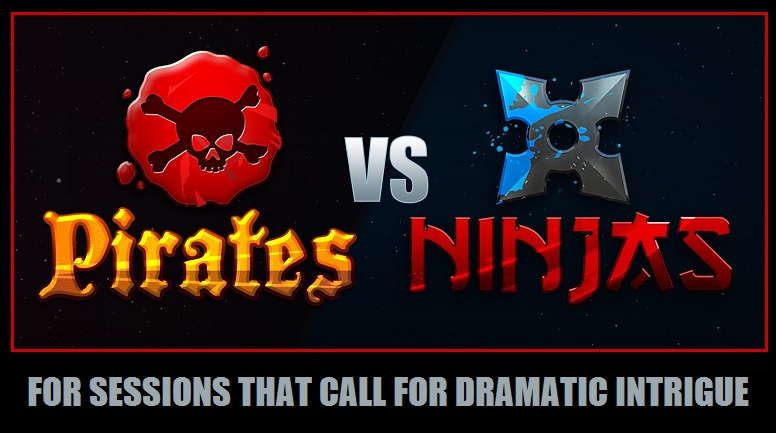Most role players have a favorite system. For many, it’s Dungeons and Dragons. Sometimes it’s Shadowrun. Hopefully, it’s never FATAL. Regardless of the specifics, it might seem that a favorite system is simply perfect. The system may follow the exact philosophy you have for gaming, it may be balanced, and it might use setting material for your favorite series. Why ever use any other system? Unfortunately, no matter how good a game may be, it can never be the best system for every campaign idea.
RPG systems, without exception, encourage certain behaviors from players and GMs. Dungeons and Dragons, for example, encourages players to fight dangerous monsters using violent methods. The built-in reward mechanisms of the game typically reward players for killing creatures, or at least entering dangerous situations and coming out alive. The game provides characters tools in order to deal with these situations, but most of those come in the form of new ways to attack enemies. In fact, there is very little support in any edition for nonviolent conflict resolution. Sure, there are spells like Calm Emotions, and skills like diplomacy, but just look at the amount of space in each book dedicated to combat rules compared to the space dedicated to explaining the diplomacy rules. The combat rules are detailed, fine-tuned, and comprehensive. Meanwhile, depending on edition, the diplomacy rules might have a single table with some explanatory text for situational modifiers. There are no real guidelines for what a success may do, beyond a vague improvement of an NPC’s attitude.
This isn’t necessarily a bad thing. It can be a lot of fun to play larger-than-life heroes who strike down evil with confidence that they’ve made the world a better place. Messing about with drawn-out negotiations can slow down an action-oriented game. Thus, the simple diplomacy rules can keep the action moving quickly. D&D has been designed as a game in which violence is a focus, and after so many years of iteration, D&D has become extremely good at creating this sort of campaign.
On the other hand, D&D is not likely to be very helpful if your goal is to create a world of intrigue, where the main characters have to be careful and only resort to violence if all else fails. Hit points, incredible magic powers, and other aspects of the game make a Game of Thrones-esque campaign all but impossible. Furthermore, the game offers very little support for running a kingdom, or the interplay of a character’s base desires and their lofty ideals. GMs have enough work to do without having to devise new mechanics that the game doesn’t provide for them.
D&D is designed with a goal in mind. It is not alone in this respect. Savage Worlds is designed to tell pulpy stories in any time period. Call of Cthulhu is designed to create a mounting sense of dread and to render player characters irrevocably insane as they discover more mysteries in the universe. The tools a system provides its players, the system’s reward structures, and the general structure of a system all combine to encourage a certain style of play from a group, whether the encouragement is intentional or not. As such, it is important for a group to not only consider their preferences in game system, but also whether that system will be appropriate for the type of game they want to run.
When trying to determine the best system for a particular kind of story, one of the best places to start is the game’s reward mechanics. AD&D, for example, rewards experience for every piece of gold a character obtains. So, to extrapolate, AD&D encourages stories about characters who seek riches and glory. Characters who lead a more humble lifestyle will fall behind treasure seekers, and slowly become less able to effect change in a story as a result. XP isn’t the only reward mechanism that can be examined to find the goal of a system, however. Savage Worlds offers rerolls and influence in the form of “bennies”. These bennies are given out whenever a player does something entertaining at the table, especially when the action makes the other players laugh, high-five, or cheer. Savage Worlds encourages players to create excitement, while discouraging the safe, slow route.
Some games offer character progression or other rewards simply for playing in a session, which doesn’t provide many hints to a system’s goal other than “this game should be played”. In this case, a group may look to the mechanisms to which a game devotes most of its pages. If a game devotes 30 pages to a detailed negotiation system, and a paragraph to violent conflict resolution, then it is likely a bad choice for a story that revolves killing zombies.
Some RPGs are extremely short, however. It is possible that these systems devote an equal amount of space to each mechanic. In these cases, one might look to the tools the game provides to players. In other words, what does the game allow players to do? If the game gives a character various options for how to kill things, it’s probably a game that expects combat to happen frequently. Conversely, a game in which characters can spend resources to activate other characters’ flaws would probably be a game more suited to telling stories revolving around slow-paced intrigue.
These are just a few ways to determine whether a system is the right system for the campaign a group wants to run. Some systems are versatile, and some systems can be molded to serve a wide variety of ideas. But in many ways, an RPG system is a tool that is used to tell a story. While it’s technically possible to pound in a nail with any heavy object, it’s almost always better to use a hammer. Accordingly, it would be a good idea to find the right tool for your campaign.


